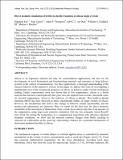| dc.contributor.author | Sen, Dipanjan | |
| dc.contributor.author | Cohen, Alan | |
| dc.contributor.author | Thompson, Aidan P. | |
| dc.contributor.author | Goddard, William A., III | |
| dc.contributor.author | Buehler, Markus J. | |
| dc.date.accessioned | 2011-10-07T19:53:36Z | |
| dc.date.available | 2011-10-07T19:53:36Z | |
| dc.date.issued | 2010-01 | |
| dc.date.submitted | 2010-05 | |
| dc.identifier.uri | http://hdl.handle.net/1721.1/66202 | |
| dc.description.abstract | Silicon is an important material not only for semiconductor applications, but also for the development of novel bioinspired and biomimicking materials and structures or drug delivery systems in the context of nanomedicine. For these applications, a thorough understanding of the fracture behavior of the material is critical. In this paper we address this issue by investigating a fundamental issue of the mechanical properties of silicon, its behavior under extreme mechanical loading. Earlier experimental work has shown that at low temperatures, silicon is a brittle material that fractures catastrophically like glass once the applied load exceeds a threshold value. At elevated temperatures, however, the behavior of silicon is ductile. This brittle-to-ductile transition (BDT) has been observed in many experimental studies of single crystals of silicon. However, the mechanisms that lead to this change in behavior remain questionable, and the atomic-scale phenomena are unknown. Here we report for the first time the direct atomistic simulation of the nucleation of dislocations from a crack tip in silicon only due to an increase of the temperature, using large-scale atomistic simulation with the first principles based ReaxFF force field. By raising the temperature in a computational experiment with otherwise identical boundary conditions, we show that the material response changes from brittle cracking to emission of a dislocation at the crack tip, representing evidence for a potential mechanisms of dislocation mediated ductility in silicon. | en_US |
| dc.description.sponsorship | United States. Army Research Office (W911NF-06-1- 0291) | en_US |
| dc.description.sponsorship | United States. Defense Advanced Research Projects Agency | en_US |
| dc.description.sponsorship | National Science Foundation (U.S.) | en_US |
| dc.language.iso | en_US | |
| dc.publisher | Cambridge University Press | en_US |
| dc.relation.isversionof | http://dx.doi.org/10.1557/PROC-1272-PP04-13 | en_US |
| dc.rights | Article is made available in accordance with the publisher's policy and may be subject to US copyright law. Please refer to the publisher's site for terms of use. | en_US |
| dc.source | Materials Research Society | en_US |
| dc.title | Direct atomistic simulation of brittle-to-ductile transition in silicon single crystals | en_US |
| dc.type | Article | en_US |
| dc.identifier.citation | Dipanjan Sen, Alan Cohen, Aidan P. Thompson, Adri Van Duin, William A. Goddard III and Markus J Buehler (2010). Direct atomistic simulation of brittle-to-ductile transition in silicon single crystals. MRS Proceedings, 1272 , 1272-PP04-13 doi:10.1557/PROC-1272-PP04-13 © Materials Research Society 2010 | en_US |
| dc.contributor.department | Massachusetts Institute of Technology. Department of Civil and Environmental Engineering | en_US |
| dc.contributor.department | Massachusetts Institute of Technology. Department of Materials Science and Engineering | en_US |
| dc.contributor.approver | Buehler, Markus J. | |
| dc.contributor.mitauthor | Sen, Dipanjan | |
| dc.contributor.mitauthor | Cohen, Alan | |
| dc.contributor.mitauthor | Buehler, Markus J. | |
| dc.relation.journal | MRS Proceedings | en_US |
| dc.eprint.version | Final published version | en_US |
| dc.type.uri | http://purl.org/eprint/type/ConferencePaper | en_US |
| dspace.orderedauthors | Sen, Dipanjan; Cohen, Alan; Thompson, Aidan P.; Van Duin, Adri; Goddard III, William A.; Buehler, Markus J | en |
| dc.identifier.orcid | https://orcid.org/0000-0002-4173-9659 | |
| mit.license | PUBLISHER_POLICY | en_US |
| mit.metadata.status | Complete | |
